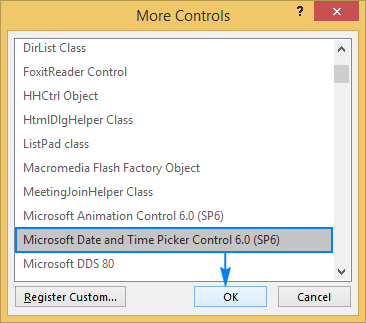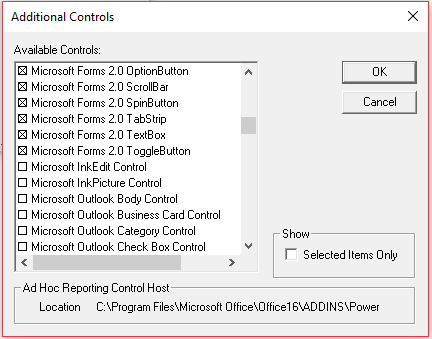The problem I'm now seeing is the error about missing on the Common. Visual Studio 6.0. The MonthView control enables you to create applications that let. Install the MSCOMCT2.OCX file in the user's Microsoft Windows System. I have a client who uses the date picker from Microsoft MonthView Control 6.0 (SP6). VBA Project-Toolbox-Addtional Controls-Missing the Microsoft MonthView Control 6 option I am building a form and need the Microsoft MonthView Control 6 (SP4) option to insert a calendar for choosing a date. Mainstream Support for Microsoft Visual Basic 6.0 ended on March 31, 2005. However, we are releasing this non-security related package because it contains improvements that were ready for release just prior to the end of Mainstream Support. Microsoft Visual Basic 6.0 has transitioned to Extended Support which runs through March 31, 2008.
I've developed a tool using VBA in Excel 2002 (XP) and I have used the Microsoft MonthView Control 6.0 (SP6). I need the workbook and attached form to work on a Windows XP machine that doesn't have MSCOMCT2.ocx installed. Due to administrator restrictions on each machine (and the resources required to update each and every machine with this file) I am unable to run as I get an 'object missing' error when I run the userform. Gem Ws1 Oriental Manual there. Is there any way I can use the MonthView control without having to install it on each machine.
Hope someone can help. Try a web search on 'vba calendar'. There's lots out there. I can't vouch for any of them (I haven't tried any), but I do suggest before you download any that you make sure they'll work with your date format (eg mm-dd-yy vs dd-mm-yy), and as most of them are downloaded in Excel format it would be wise to run a virus scan on them before opening (although that won't save you from nasty code). I've used the Calendar control successfully on a fairly tight security network. The reason I was able to is that the Calendar Control is standard with Office Professional (and also with stand-alone Access, but I think not with stand-alone Excel), and all our PCs have Office Pro licenses, so that control was already available. Another possibility might be the standard Windows MonthCalendar and DateTimePicker controls.
These are system controls, so they won't be as straightforward as using Excel or Office controls. I'm sure it's possible to access them via VBA, but I've never done so and am unlikely to be able to offer much advice should you go that path. To use the MonthView control in your application, you must add the MSCOMCT2.OCX file to the project. When distributing your application, install the MSCOMCT2.OCX file in the user's Microsoft Windows System or System32 directory. That certainly sounds as if it has to be installed. A quick web search seems to confirm this.
If all the PCs have Office installed, though, they probably all have the Calendar control. Would that serve your purpose, or are you using some functionality of MonthView that calendar doesn't have? NB if they are running different versions of office this can get messy, as the name of the library includes the version number, so you have to reference all the versions in your project, with higher numbered versions taking precedence, to ensure it will work on all. Try a web search on 'vba calendar'. There's lots out there. I can't vouch for any of them (I haven't tried any), but I do suggest before you download any that you make sure they'll work with your date format (eg mm-dd-yy vs dd-mm-yy), and as most of them are downloaded in Excel format it would be wise to run a virus scan on them before opening (although that won't save you from nasty code). I've used the Calendar control successfully on a fairly tight security network. The reason I was able to is that the Calendar Control is standard with Office Professional (and also with stand-alone Access, but I think not with stand-alone Excel), and all our PCs have Office Pro licenses, so that control was already available.
To start with, you'll need to download this file from the Microsoft support site. When you've clicked the link to start downloading the file, choose to save it somewhere on your computer. On the dialog box which appears, check the box next to the entry for the Microsoft Date and Time Picker Control 6.0.
Another possibility might be the standard Windows MonthCalendar and DateTimePicker controls. These are system controls, so they won't be as straightforward as using Excel or Office controls. I'm sure it's possible to access them via VBA, but I've never done so and am unlikely to be able to offer much advice should you go that path.


If you are working for an old application you may be presented with the error:
Component ‘MSCOMCTL.OCX’ or one if its dependencies not correctly registered: a file is missing or invalid:
In this case you have two tasks to complete and neither of them are obvious:
DOWNLOAD MSCOMCTL.OCX
MSCOMCTL.OCX is part of Visual Basic 6 Package and you can download you can just download the MSCOMCTL.OCX directly from us HERE.
UPDATE – MAY 2020- Alternately you can surf to the following address but we removed the clickable link because one of our security checks has marked it as an “aggressive site” so use at your own peril: daydownloads.com/microsoft-visual-basic-6-common-controls/
INSTALL MSCOMCTL.OCX
You need to know if you are using a 32bit or 64bit version of Windows and because this is not 2002, we are assuming you want to install it on a 64bit PC. If you try to register MSCOMCTL.OCX (which is 32 bit) on a 64 bit system and you put it in the typical C:WINDOWSSYSTEM32 folder you will get:
Vba Monthview Control
THE MODULE ‘MSCOMTRL.OCX’ WAS LOADED BUT THE CALL TO DLLREGISTERSERVER FAILED WITH ERROR CODE 0X8002801C
Microsoft Monthview Control Missing
- If you are using 64 bit Windows copy the MSCOMCTL.OCX to C:WINDOWSSYSWOW64
(If you are using 32 bit Windows copy MSCOMCTL.OCX to C:WINDOWSSYSTEM32)
. - Open a CMD or PowerShell prompt (as an administrator) and change into C:WINDOWSSYSWOW64
. - Type
regsvr32 mscomctl.ocx
- Press ENTER
- Enjoy